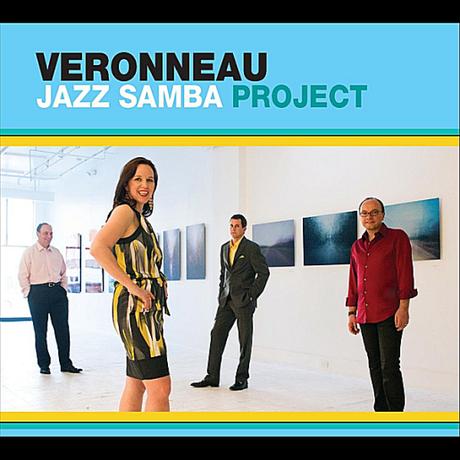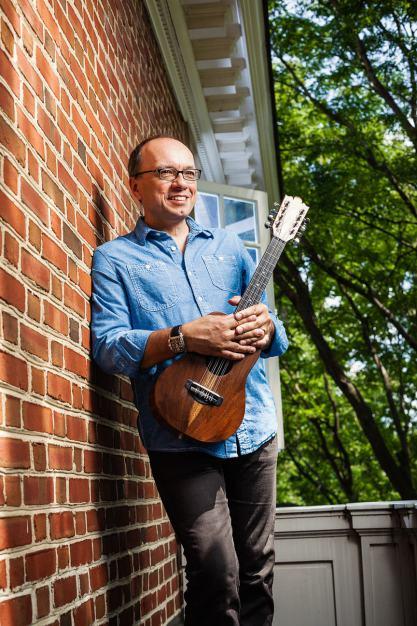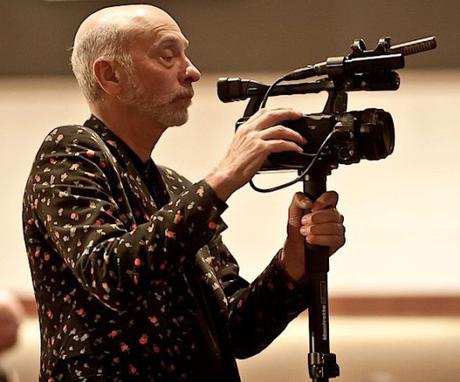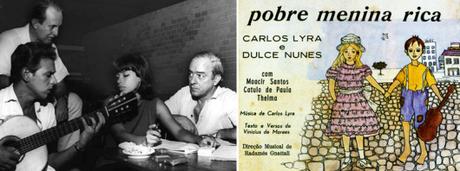Music that Soothes the Soul
 Veronneau: Jazz Samba Project, with Lynn Veronneau and husband Ken Avis (far right)
Veronneau: Jazz Samba Project, with Lynn Veronneau and husband Ken Avis (far right)
It was such a pleasure to have met and chatted with musician Ken Avis (albeit briefly) on Saturday, June 7, 2014, after the Jazz Samba Project Symposium. A former organizational development consultant with the World Bank Group, Ken is a sharp and knowledgeable music lover, especially of Brazil’s music. I congratulated him and his co-curator, Georgina Javor, for a most enjoyable and thoroughly professional presentation, which brought a variety of speakers together. Among them were teacher, lecturer, musician and journalist David R. Adler; teacher, composer and bassist Leonardo Lucini; editor, producer and NPR host Tom Cole; multi-Emmy Award-winning sound engineer Ed Greene; and professor and author Charles A. Perrone.
The symposium itself was a huge success, as was my talk the following Sunday afternoon with drummer Buddy Deppenschmidt (see the following link to my interview: https://josmarlopes.wordpress.com/2015/12/28/its-jazz-samba-time-celebrating-the-50th-anniversary-of-the-landmark-bossa-nova-album/). Buddy turned out to be a terrific interview subject: involved, alert and ready with a memorable line or two. It was incredible how he managed to recall events from fifty years back with such facility, and in precise detail. And having Jazz Samba’s original sound engineer Ed Greene on the stage and alongside him was icing on the bossa nova cake.
My only regret was that my wife and I missed the Sunday afternoon performance of Ken’s group Veronneau with German-born harmonicist Hendrik Meurkens. Regrettably, we had to rush back to our hotel to catch the shuttle to Dulles Airport. I also regret not having seen the world premiere of Ken Avis and Bret Primack’s documentary, Bossa Nova — the Brazilian Music that Seduced the World. I asked Ken afterwards if and when the documentary would be made public, either online or on his group’s Website. He was kind enough to send me the link to Primack’s YouTube channel where I could watch the film “in the raw.” Ken assured me it was chock full of fascinating tidbits that a history maven and pop-music buff such as myself would be thrilled to have at my disposal.
While we’re on the subject, Ken also provided me with a copy of a CD he recorded in 2012. Under the title Jazz Samba Project, it was his group’s homage to the milestone Jazz Samba album from 1962. My initial thought was that it was smooth sounding, suave and sophisticated, as only bossa nova was meant to be. The lilting rhythms and additional percussion effects were added virtues, while his wife Lynn’s easy-going vocals fit in beautifully with what I like to refer to as the “Astrud aesthetic” (named after Astrud Gilberto, the former wife of bossa nova pioneer, João Gilberto, who shot to stardom on the strength of her English-language rendition of “The Girl from Ipanema”).
I did have a few reservations with Lynn’s Portuguese pronunciation, though. Heck, even pop singer Lani Hall, one of two artists featured (the other being Janis Hansen) with Sérgio Mendes and Brasil ’66 on their many A&M albums, wasn’t all that perfect. Still, it did not detract from the generally relaxed vibes I got from the players. And the recording venue, All Souls Unitarian Church in Washington, D.C., where the original Jazz Samba sessions took place, was heaven sent. While duplicating three of the selections from the original record (“È Luxo Só,” “One Note Samba,” and “Samba Triste”), Veronneau also covered the Bob Marley tune “Waiting in Vain,” Jorge Ben’s perennial “Más Que Nada,” Jobim-Mendonça-Gimbel’s “Meditation,” one of Baden Powell and Vinicius de Moraes’ afro-sambas, “Samba Saravah,” the Joseph Kosma-Johnny Mercer standard “Autumn Leaves,” and lastly Jobim’s “Wave.”
Getting back to the bossa nova documentary, Ken mentioned to me that “it’s still a work in progress and won’t see the light of day formally until [he and Bret] are able to raise a bit more money for film festival showings, etc.” All the same, Ken urged me to take a gander at it. “I’m sure you will have seen many of the clips before,” he added, “but there’s a lot of new original interview material in there too. There are some things we will change but this is it as of today!”

Ken was absolutely spot-on regarding the documentary. There were clips (most of them from second-generation footage) that I had never seen before: a rare showing of composer-guitarist Luiz Bonfá with Perry Como performing “A Day in the Life of a Fool” (known in Brazil as “Manhã de Carnaval”), the persnickety João Gilberto in an extended take on “Desafinado,” glimpses of Stan Getz and Charlie Byrd in concert, Elis Regina with Tom Jobim hamming it up on “Águas de março” (“Waters of March”), Vinicius and Tom in a rendition of “Felicidade,” and an interview with Charlie Byrd’s brother, Joe Byrd. In that one, Joe Byrd claimed, in his elegantly patrician Virginia accent, that brother Charlie called on the services of “two German drummers” — American-born Buddy Deppenschmidt and Bill Reichenbach — to man the rhythm section.
As for my talk with the “German drummer” William “Buddy” Deppenschmidt III (who is of Danish ancestry on his mother’s side), Ken had this to say: “I wish I could have caught the Sunday morning session — I heard from a couple of people who had been there, including the [Brazilian] drummer Vanderlei Pereira that it was interesting and entertaining. I [felt that] Buddy and his companions had a really good time at the festival and were delighted at the opportunity to be part of it, which for me is one of the best things we achieved.”
I asked Ken if he had ever heard of David Chesky and his audiophile label, Chesky Records. “I can recommend many of their CDs,” I wrote back, “especially the one called Club de Sol that highlighted composer-musician Chesky on piano with Brazilian percussionist Café, who my wife and I had met when we lived in New York (see the following link to my story, “Jazz Can’t Resist Brazil”: https://josmarlopes.wordpress.com/2012/08/27/jazz-cant-resist-brazil/). “It’s a wonderful album of all original material, very bossa-nova tinged and jazz oriented — plus it swings, man, it swings! I guarantee you will love it if you haven’t heard it yet.
“I also have two of their earlier compilations (they double as sound checks, too), some of which featured singer Ana Caram, guitarist Badi Assad (she is part of an incredibly talented guitar-playing family that includes her two brothers, Sergio and Odair Assad), Livingston Taylor (James Taylor’s brother), Orquesta Nova, and a bunch of others. It’s all very eclectic stuff.”
My suggestion must have caught Ken’s ear. He wrote back to me after about a week: “When you mentioned Chesky I was aware of the label and a couple of days later I pulled out a compilation CD from them which I had bought years ago. It introduced me to [Bahian-born] Rosa Passos, who had a version of “Girl from Ipanema,” a Colombian singer Marta Gomez, who did a beautiful arrangement of “Cielito Lindo,” and included a bunch of other great tracks such as a bass and male vocal version of “Round Midnight.” If we were with a label, that’s the one I’d like to be with!”
With that said, I made up my mind to write to videographer and music journalist Bret Primack directly and introduce myself. Having put in a plug for one of my all-time favorite albums, I decided to pull out a couple of those Chesky CDs I had told Ken about. As I began to peruse the liner notes, lo and behold, I realized that Bret had written the notes himself. No wonder Ken knew about the label!
Call Me, On the Line

It was no surprise to me that Bret was a Brazilian music lover, as were David and his brother Norman Chesky. They owned (and founded) the Chesky Records label back in the late 1980s and continue to do so today. I quickly answered back: “I love their stuff! I have several excellent CDs of theirs including the two demo discs, which I still use on occasion to get the imaging right on my speakers.”
I felt an inspiration coming. Here is the gist of what I wrote to Bret: “I got your e-mail address from Ken Avis, who I met last weekend at the Strathmore after the Jazz Samba Symposium. Ken was kind enough to send me the video link to your film, Bossa Nova: The Music that Seduced the World, which I thoroughly enjoyed. My congratulations! I know he spoke with you about the making of, and genesis, of the film. I’d like to correspond with you about it, if you have some free time.
“The interesting thing is that I recommended several recordings to Ken of Brazilian music on the Chesky label. He told me he was familiar with the label. The CDs I suggested were a recital by [Brazilian jazz singer] Leny Andrade with pianist Fred Hersch — in particular, her powerful singing of the song “Wave,” which I think is a standout; and David’s Club de Sol. I would have added Herbie Mann’s Caminho de Casa (see the link to my article about this album: https://josmarlopes.wordpress.com/2012/09/03/a-brazilian-at-heart-for-jazz-artist-herbie-mann-brazil-was-home-too/), but his name did not come up in our conversation.
“Coincidently, I pulled out Caminho de Casa and a Luiz Bonfá CD (also on Chesky) called Non-Stop to Brazil, both of which are favorites of mine. As I perused the liner notes, I noticed that YOU wrote the notes! I knew, by the way you and Ken had discussed bossa nova in your film, that you must love or at least be familiar with Brazilian music. I had no idea you wrote the liner notes to my favorite works!” I also told Bret about my having met the percussionist Café.
“Please let me know if we can discuss your film. I even suggested to Ken a possible avenue for funding your project via the Audiovisual and Rouanet Laws in Brazil (I don’t know if they apply here, but you can most certainly give it a try). Ken told me he was going to check into them as well. Anyway, I look forward to hearing from you.”
After several false starts, I was able to speak to Bret. I had no idea the Chesky brothers were his cousins! We had a most satisfactory conversation, for which I thanked Ken. Bret hailed from the suburbs of New York. He started booking bands while still a teenager. Wherever he went, Bret met up with Brazilians who were passionate jazz and music lovers. After years in the city, Bret moved out West — to Tucson, Arizona, where he set up a jazz video outlet. He became known as the Jazz Video Guy. Some of his YouTube videos include “Miles Davis, the Picasso of Jazz,” and a series about the life and work of saxophonist Sonny Rollins. In our talk, Bret hinted that in order to complete the Bossa Nova film project he would need access to better archival footage as well as additional funding sources. Perhaps a trip to Brazil would be in order.
What really got my attention was that Ken mentioned using the unexpected avenue of the theater, by way of a possible play about the coming of bossa nova to the U.S. I took advantage of the opportunity to discuss, via our e-mail correspondence, a ready-made theater piece that many authorities consider to be the first (and, to date, only) bossa nova musical. That would be Pobre Menina Rica or “Poor Little Rich Girl,” a 1964 play (in the form of a cabaret piece) with lyrics and text by none other than Vinicius de Moraes, and songs by Carlos Lyra, a still-living icon of the bossa nova era.

I told Ken that I had a CD of the music, as well as the original text (in both Portuguese and English) in my possession. “You can read about the musical in Ruy Castro’s book Chega de Saudade, translated under the title Bossa Nova: The Story of the Brazilian Music that Seduced the World” — a not inconsequential resemblance to Primack and Avis’ film title.
Suffice it to say that the plot line and music for Pobre Menina Rica are definitely of its time. The story is of the “poor-boy-meets-rich-girl” variety, result: love at first sight, the sort of innocent, innocuous fling that prevailed in the mid-1960s. The best examples I could think of were those Frankie Avalon-Annette Funnicello “beach blanket bingo” flicks from the same period. It may not have been what Ken was looking for, but it did touch on themes related to class differences (one of the main characters is a crippled Afro-Brazilian slum dweller, highly reminiscent of Porgy from George Gershwin’s Porgy and Bess). Leão and Elis Regina were originally pegged to star in the show when it premiered. In fact, Lyra wrote the musical with Nara in mind: she’s the titular “Poor Little Rich Girl,” which as we know was the title of a Noël Coward song.
I offered to send Ken the text to read over. “You can probably download some of the songs online as well. If this perks your interest, I can even reach out to my friends in Brazil, Claudio Botelho and Charles Moëller (of Moëller-Botelho) who I have written about extensively on my blog.” For years, Carlos Lyra had been dying for someone to bring his play either to Broadway or to North American theaters in some capacity. It was another way of approaching Ken’s idea, but from a different angle, outside of writing something from scratch (which is more difficult).
However, Ken decided to give the project his own spin, the result of which was an original play called Bossa Fever! — When Samba met Jazz in 1960s Washington DC, with music by his band Veronneau. The world premiere took place in 2015 at the Atlas Performing Arts Center in D.C., as part of the INTERSECTIONS 2015 Festival (here’s the YouTube link to the show: https://www.google.com/url?sa=t&rct=j&q=&esrc=s&source=web&cd=1&cad=rja&uact=8&ved=0ahUKEwjg06GilYTXAhVFWCYKHXQjCRwQtwIIJjAA&url=https%3A%2F%2Fwww.youtube.com%2Fwatch%3Fv%3DXadG42P5DuA&usg=AOvVaw13PclTp0Xgyoy_XEBq2EFk).
(To be continued…)
Copyright © 2017 by Josmar F. Lopes
Advertisements
